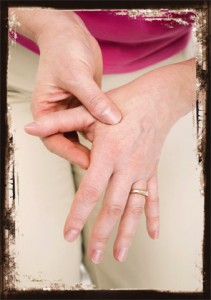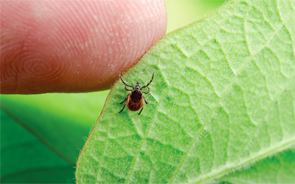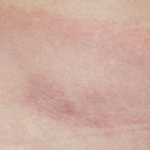
RA is typically symmetric and, early on, usually involves the small joints
of the hands and feet.
Image Credit: Lea Paterson / Science Source
What struck me first as I walked by the exam room where Lynn P. sat was the swelling in her fingers and wrists. The bloated hands rested unnaturally on her thighs, palms up, fingers slightly flexed. Her strawberry-blond curls were offset by a high-neck, loose-fitting, burgundy sweater. Her pale skin matched her trim slacks. She had an air of straightforward expectation, as if she might hold out her misshapen hands and ask if she could have a refund for another, better functioning, pair.
Outside the room, I picked up the chart and skimmed through the notes her internist had forwarded: Two months post-partum…uncomplicated pregnancy …healthy 7 lb., 6 oz. boy … breastfeeding, abrupt-onset swelling of fingers and wrists. Next visit: Swelling increased in fingers, worse in am, toes, ankles, knees stiff … Ibuprofen, minimal benefit. And then: Trouble holding baby, lab studies okay, getting worse by the day. Rheumatology referral.
I turned to the information sheet she’d filled out: 27 years old, born in Portland, Maine. Married. First pregnancy. No significant past medical history. No surgeries. No allergies. Non-smoker. I can see where she crossed out her original answer, no alcohol, to well, I had a glass of wine last week to see if it could help me sleep, but no luck!
Ever so gingerly, I shook her hand as I entered the room. The wrists and fingers were a boggy, swollen mass of inflammation. She limply withdrew her hand and thanked me for seeing her on short notice. Only then did I notice the baby in the carrier tucked under the table at her feet.
Post-Partum-Onset Inflammatory Arthritis
The mysterious onset of inflammatory arthritis beginning shortly after childbirth has a limited differential diagnosis. It’s mysterious in that affected women usually have no history of previous health problems, the delivery was uncomplicated and the baby is completely well. In the usual case, the patient has had no change in diet or unusual exposures, no preceding illness or warning. One day, the new mother is well, the next her joints begin to stiffen and swell.
I mulled over the possibilities. Despite the absence of the usual signs—fever, cough, rash, diarrhea—perhaps Lynn P.’s swollen joints were manifestations of infection. As I examined her neck for signs of lymph node enlargement and palpated her abdomen, I recalled that Parvovirus B-19 may trigger incapacitating arthritis. True, most patients have a prodrome of fever and rash, but from time to time, I’ve seen patients who lack these typical signs. It’s worth checking for. Lyme disease? No, wrong joint distribution and her Lyme test was non-reactive.
Rheumatologists often arrive at a definitive diagnosis in a decidedly low-tech fashion. Patiently teasing out a complete history narrows the possible explanation for the patient’s symptoms. The distribution of tender or swollen joints also helps. … Rheumatoid arthritis typically is symmetric …
I mulled over the other possibilities. Occasionally, a reaction to a prescription medication or other connective tissue disorders, such as lupus or scleroderma, may present in this fashion, but as I examined her heart and lungs and checked her skin for a subtle rash, I was convinced these were unlikely as well.

Lyme disease is transmitted to humans via the bite of infected blacklegged ticks.
Image Credit: PHOTO FUN/shutterstock.com
She held out her hands. Not all of the joints were affected. The small joints adjacent to the fingernails were uniformly normal, while the middle joints of the fingers and knuckles were tender and swollen. She flinched when I flexed and extended the wrists. Sliding my examining hand up the forearm, a firm nodule the size of a marble was palpable at the bony prominence of both elbows.
Rheumatologists often arrive at a definitive diagnosis in a decidedly low-tech fashion. Patiently teasing out a complete history narrows the possible explanation for the patient’s symptoms. The distribution of tender or swollen joints also helps. Lyme arthritis, for example, affects a single knee in 80% of cases. Swelling of all three joints in a single finger or toe (giving the appearance of a sausage digit) is characteristic of psoriatic arthritis or ankylosing spondylitis, while the arthritis of Crohn’s disease—an immune system disorder affecting the bowel—primarily affects the large joints of the lower extremities, the knees and ankles.
Rheumatoid arthritis (RA) typically is symmetric and, early on, usually involves the small joints of the hands and feet. The growths at Lynn’s elbows sealed my opinion; they were almost certainly rheumatoid nodules.
The Diagnosis
Already a wife and mother, Lynn P. was now, and into the foreseeable future, an RA patient. The difficult work of adjusting to a chronic, uncertain and, sometimes, crippling lifelong disease lay before her.
Finishing my exam, I reviewed the labs Lynn’s internist had ordered. Levels of inflammation, a C-reactive protein (CRP) and erythrocyte sedimentation rate (ESR) were normal and her rheumatoid factor was absent. But that’s not unusual; laboratory tests are often normal in early RA, even in the presence of florid joint swelling. In the first six months of the disease, rheumatoid factors are positive in only 50% of cases. Even adding a newly developed, more specific test, an antibody to anti-cyclic citrullinated peptides (CCP), brings this number up only to 80%.
Ultimately, Lynn has RA, because—and this sounds oddly pompous—because I say so.
But at today’s initial visit, I hedged. Although I was confident that Lynn P. had RA, I was not 100% certain, and there was something about her demeanor—she’d volunteered almost nothing besides simple yes and no answers to my questions—that made me hesitate. I realized I had no sense of who she was beyond the bare bones of the questionnaire she’d filled out in the waiting room.
Even so, it was time to tell her what I thought was wrong. “There’s no doubt that you have inflammatory arthritis,” I began, as I closed her chart, “but some viral infections can affect the joints severely. The good news is that they gradually wind down and resolve completely. But there’s also the high likelihood this represents early rheumatoid arthritis.” I paused.
Questions? Shock? Disbelief? Nothing: She was hard to read. “I want to draw further labs, and here’s a pamphlet to review on rheumatoid arthritis. It’s published by the Arthritis Foundation, and I’ll set aside time next visit to answer any questions you might have.
“In the meantime,” I pulled out my prescription pad, “for a few weeks, I want you to take a low dose of a medication called prednisone.” I handed her the prescription. “No matter what the trigger for your arthritis, it should quiet down the pain and swelling. But first, let me tell you about potential …”
Her eyes widened. There was a distrustful tone to her voice. “Prednisone? Isn’t that a steroid?”
“Yes …,” and without skipping a beat, I reviewed the potential side effects of prednisone, how it was safe to take in small amounts in breast-feeding mothers, but that taking high doses of the drug long term often leads to weight gain, elevated blood sugars, hypertension and even brittle bones. “At the dose I’m recommending, it’s the most effective medication we have to quiet down severe arthritis inflammation.”
She asked, “Do I have severe inflammation?”
“I’m afraid so.”
She exhaled. “And, my baby? I’m breastfeeding. You can’t, I mean, it’s going to poison him too, isn’t it?”
It was my time to exhale. After a successful pregnancy and the miracle of an uncomplicated delivery, a doctor she barely knows wants her to take a medication that goes against every maternal instinct, every fiber of her being, but “poison”? I flipped through the patient information sheet she’d filled out and ran my finger down her history. Vegetarian. Hmm, this is going to be challenging.
The Patient’s Perspective
I’m fully aware that bias has crept into my evaluation. I agree that eating a natural plant-based diet is undeniably healthier than the diet many of my patients consume—top heavy in red meat, loaded with fat and processed snacks—but some vegetarians operate in a rigid belief system in which disease, whether it’s cancer or heart disease, or in this case, inflammatory arthritis, can be treated by adhering to a strict vegetarian diet.
I wish it were so. Although numerous studies have shown that the risk of developing various disorders (e.g., heart disease, colon cancer, hypertension, diabetes, to name but a few) may be reduced in vegetarians, it’s not an absolute cloak of protection. This is a difficult truth for some vegetarians to accept: Sometimes horrific disease happens to good people on healthy diets. This explains why, when an unexplained illness hits, many vegetarians further restrict dietary intake. I asked Lynn if she had changed her diet recently.
“No, I’ve been a vegetarian for 10 years. No change there. Well, that’s not exactly true,” she added. “For the last two months, after this hit me out of the blue,” she held out her hands, “I’ve eliminated gluten. And last month, after reading about vegetables in the nightshade family triggering arthritis—you know, tomatoes, potatoes, sweet peppers—I took them out of the mix as well.”
“And has that helped?” I asked.
“Not yet.” She shook her head in puzzlement. “But last week I eliminated milk and milk products and started supplementing with bromelain, borage oil, devil’s paw, willow bark, fish oil and turmeric.” Her son stirred from his nap. Cooing in a soft, caressing, sing-song lilt, she leaned forward and rocked the carrier until he settled down again.
“And has that helped?”
“They say it takes time for the toxins to be eliminated.”
From past experience, I knew where this was headed, but I persevered. “The supplements might help a little, but in my experience they don’t help with this degree of inflammation. I wish it were as simple as eliminating this food or supplementing with this nutrient.” I paused, but she was closing down, categorizing me, her mind made up to avoid prescription medications.
The haunting image of a young woman, no older than Lynn, came to me. Years ago, while lecturing on arthritis care at a rural hospital outside of Bangalore, India, I was asked to make a home visit. I agreed, and was taken to a tin-roofed, cement-block home set on the edge of a dry, golden field of wheat. Entering, my eyes took time to adjust to the cool darkness inside. A cot with a rumpled white sheet was at the far end of the room. The mother lightly touched my arm. Her daughter lay beneath the sheet, 26 years old, 85 lbs., her hips and knees contracted to her chest, her elbows unable to extend and her fingers unable to flex or pinch or grip.
For millions of people around the world where disease-modifying treatment is unavailable, this is the natural history of RA: chronic pain, relentless joint destruction, immobility, early death.
The mother knelt down and brushed her daughter’s hair back with a free hand and held a cup of water to her lips. Even if aggressive disease-modifying medications were available (they were not), it was too late. Joint replacement surgery might improve function—if I could convince one of the local orthopedic surgeons to operate—but the disease would continue to consume her without aggressive, unavailable immunotherapy.
Lynn was asking me a question.
“Why do you think this isn’t Lyme disease?” Her tone was sharper, confrontational.
Lyme Disease
I’ve lost the current battle. I know this, but I explained my rationale. “We see a lot of Lyme arthritis here in southern Maine. Most cases present with solitary swelling in a single joint, usually the knee. If it involves more than one joint, it tends to be asymmetric, say, the left ankle and the opposite wrist. No one knows why, but that’s the pattern. Although Lyme disease, in special circumstances, may not test positive, by the time people have arthritis, the screening test is very reliable. Your doctor tested you for Lyme disease and the test was negative.”
“Can you test me again? I’ve read that the infection can hide and the test can be negative one time and positive the next.”
Internally, I was scrambling. “I’ll test your blood for Lyme disease at a local research lab that specializes in immunologic research,” I answered. “I’ll add a test for parvovirus, which can sometimes trigger inflammatory arthritis, and a recently developed test called CCP that helps us diagnose early rheumatoid arthritis when the rheumatoid factor is absent. In the meantime, would you consider taking a small dose of prednisone? You can barely dress. It must be … difficult taking care of the baby. If you’re uncomfortable about the prednisone and breastfeeding, you can check with your pediatrician.”
Handing me back the prescription, she agreed to the additional lab, but not the prednisone. On the billing sheet, I checked off the lab and additional time for an extended follow-up visit in two weeks. Cradling the baby carrier at the crook of her elbow, she limped ever so slightly down to the lab.
Rheumatoid Arthritis Explained
What exactly is RA? And how is it possible that one morning not long before, I had diagnosed a 101-year-old woman with new-onset disease and my very next consult was a 3 year old with the same disorder?
To start, RA appears to be a disease of relatively recent onset. Medical anthropologists have sifted through burial sites for evidence of RA in both the New and the Old Worlds, with radically different findings. Rothschild and Woods published the earliest findings from Indian burial ground skeletons in the Ohio River Valley in the U.S.1 Even after thousands of years, the joints of the skeletons examined by the researchers retained the typical destructive patterns of RA: symmetry, damage to small joints more so than large joints, and sparing of the lower spine.
In contrast to the Americas, skeletal evidence for RA prior to the 1700s in Europe, Asia and Africa is fragmentary and unconvincing. RA’s rarity in the Old World until relatively recent times may explain why the first recognized description of RA in the European medical literature was not until 1800 by the French physician Dr. Augustin Jacob Landré-Beauvais.2 The name rheumatoid arthritis itself was not coined until 1859 by British rheumatologist Dr. Alfred Baring Garrod.3
For millions of people around the world where disease-modifying treatment is unavailable, this is the natural history of RA: chronic pain, relentless joint destruction, immobility, early death.
But if RA simmered for thousands of years in the Americas, what events led to its establishment in Europe and beyond? Infections are transmitted in the blink of an eye; the transmission of smallpox, a virus previously unknown to Native Americans and spread by European settlers, led to the rapid extinction of entire tribes up and down the Eastern Seaboard of the Americas. The emergence of RA in Europe didn’t follow the usual pattern of infection. Whole families were not afflicted. Sporadic cases were the rule. Seemingly, it just appeared.
Paul Ehrlich, an early 20th century German physician, coined the term Horror Autotoxicus to capture the frightening concept that immune system cells can, in certain circumstances, damage the very organs they’re designed to protect.4 Today, we recognize RA as an autoimmune disease. But there has always been a lingering question of whether infection might act as a triggering event for the disease. In recent decades, however, despite our ability to increasingly identify life at the molecular level, no persistent infection has been documented in the joints of patients with RA.
If it’s true that there is no straight line between infection and RA, recent work in genetics and oral health has led researchers to reconsider the role of chronic infection as a permissive factor for the development of RA. For decades, it’s been recognized that the HLA-DR4 gene is a risk factor for both RA and a seemingly unrelated inflammatory condition, periodontal disease.
Low doses of prednisone can improve pain & swelling [in RA], but slower acting medications, such as methotrexate, sometimes in combination with … Enbrel or Remicade, enable us to successfully manage this terrible disease.
One particular bacterium in chronic periodontal disease, P. gingivitis, has come under increasing scrutiny. P. gingivitis has the singular ability to citrullinate peptides (substituting a citrulline amino acid for alanine). The altered citrullinated peptides could then be recognized as non-self by the immune system and, in an as yet poorly understood manner, trigger a cascade of immunologic events leading to the development of RA. Bolstering this theory is the recognition that antibodies against citrullinated peptides (CCP antibodies) not only appear years before RA patients develop their disease, but can be isolated from the joints of RA sufferers.
What acts as an accelerant to periodontal disease? Smoking. In fact, the combination of heavy cigarette use, periodontal disease and positive HLA-DR4 status raises the relative risk of developing RA by as much as 20 times as compared with the general population.5 What’s more, the recognition of RA in the Old World followed the importation and heavy use of tobacco from the New World, a form of Cosmic Payback for the catastrophic decline of Native Indian tribes from the European introduction of smallpox.
Back to Our Patient
But if so, what of Lynn P.? How did she fit into this working hypothesis? As a lifelong nonsmoker with pristine teeth and gums, why had she developed RA? The oral bacterial trigger hypothesis would seem to be incomplete.

Crohn’s disease is an immune system disorder affecting the bowel and can be accompanied by inflammatory arthritis.
Image Credit: CRYONOID Custom media/shutterstock.com
When Lynn returned, I noticed that she’d canceled her two-week follow-up and rescheduled, now three months later. The baby wasn’t with her, but her shaggy-haired husband, John, was. He rested an elbow on the arm rest and extended one finger along his cheek, another between his lips, giving him a thoughtful, relaxed appearance. I sat on a swivel stool half facing a narrow wall-mounted desk where I could take notes.
I could see that Lynn had a list of questions on her lap. It took her two attempts to unfold the yellow-lined papers. When the pen slipped from her hand, she awkwardly bent and tried to retrieve it before her husband, without a word, reached down and placed it back in her hand.
“Well, I hope you have some answers for me.” She casually flipped a stray band of hair away from her face and winced with the effort.
“I do. Here, let me review the lab with you and your husband.” Hearing this, John leaned forward. “The sedimentation rate and this other test, the C-reactive protein, are elevated. You might remember that early on, when your doctor tested them, they were in the normal range. They don’t tell us specifically the cause of your inflammation, but they give us a good sense of severity. And here, the parvovirus test. It’s negative.” I handed the papers to Lynn, who in turn passed them on to her husband.
Numerous studies have shown the risk of developing various disorders (e.g., heart disease, colon cancer, hypertension, diabetes, to name but a few) may be reduced in vegetarians, but it’s not an absolute cloak of protection.
“This last test, though,” I ran my finger mid-way down the next page, “this other test is significant. It’s an antibody against what we call cyclic citrullinated peptide or CCP, and I’m sorry to say it’s markedly positive. It’s the most specific test we have for the diagnosis of rheumatoid arthritis. There’s no question in my mind; you have early, but very severe, rheumatoid arthritis.”
I paused before going on. Lynn and John stared at the paper. “Now, I want to spend a few minutes telling you about options in treatment.”
“Are you sure?” Lynn asked. “Didn’t you say you were going to retest me for Lyme disease?”
“Yes. That’s right. Here it is.” In concentrating on the CCP antibody, I’d neglected to mention the repeat Lyme test. I flipped to the next page. “The Lyme ELISA test was negative.”
“But it says here …” Lynn, seemingly anticipating my answer, unfolded the papers and pointed to a paragraph she’d copied from an Internet site, “It says here that the Western blot is more sensitive. Lots of times doctors don’t get the Western blot when the initial test is negative. Why didn’t you get that test?”
“Because,” I gathered my thoughts before deciding to confront the question head on. “I believe that approach is wrong. Among physicians, only a vocal minority believe that a positive Western blot and a negative Lyme ELISA are diagnostic for Lyme disease. You have a positive CCP test, which is seen exclusively in rheumatoid arthritis. I’m sorry, but there’s no question in my mind that you have rheumatoid arthritis, not Lyme disease.”
“But I have so many of the symptoms of Lyme disease. I could have been bitten by a tick and not known it. More than 50% of patients don’t have the rash. Here.” She handed me a copy of a website article titled: The truth about Lyme disease: What your doctor won’t tell you.
I handed it back to her. “I know. I’ve seen the list. Most of these symptoms are shared by patients who have inflammatory arthritis, no matter what the cause. It’s a view that proponents of Lyme disease believe. I don’t.” Lynn P.’s eyes were welling up. I handed her a Kleenex. “I’m sorry.”
An Opening Appears
John’s voice drifted over my shoulder. “Lynn, you’ve already done two courses of doxycycline through Dr. Barnes. Isn’t that supposed to cure Lyme disease? You were in pain enough to stop breastfeeding, but that didn’t work. You’ve fasted, and that helped a bit until you needed to eat. Now you’re popping Advil and Aleve and the supplements, done the elimination diet, the copper bracelets, and nothing’s working. You’re getting worse. You can hardly hold Abe.”
Now, this was news. In fact, as I asked Lynn to lie on the table to examine her knees and ankles, I felt that the admission she’d been treated unsuccessfully for Lyme disease might be my opportunity to initiate traditional medical management for RA.
As I methodically palpated Lynn’s joints, it was clear her disease had spread to involve the ankles, knees and elbows. Her knees ballooned out, stretching the tissues tightly over the kneecap. The motion in her right elbow was restricted to the point where she could barely flex the arm to comb her hair. With her wrists nearly immobile, she probably was having trouble even wiping herself after toileting.
“I’m sorry that you have rheumatoid arthritis,” I began. I turned my chair so I could alternate my attention between Lynn and her husband. I took her hands and lightly palpated the swollen fingers, then the wrists, then the elbows, knees and feet. “You have 22 swollen joints. Twenty-two. If we wait too long and damage sets in, we can’t reverse that. It’s done. The medications may sound scary but the overwhelming majority of patients I treat do well with them. We can stop the progression. We can put this disease to sleep.
“Low doses of prednisone can improve pain and swelling now,” I continued, “but it’s the slower acting medications, such as methotrexate, sometimes in combination with what we call biologic response modifiers, such as Enbrel or Remicade, that enable us to successfully manage this terrible disease.”
“Doc, she’s crying in her sleep. She had to quit her job. She can’t hold the baby,” her husband’s eyes were puffy and bloodshot.
Today, we recognize RA as an autoimmune disease. But there has always been a lingering question of whether infection might act as a triggering event for the disease. However, no persistent infection has been documented in the joints of patients with RA.
“Then I think I should inject the wrists and knees with cortisone,” I answered.
Surprisingly, Lynn silently nodded her consent. I was floored. I poked my head out the door before she could change her mind and asked my nurse, Cathy, to set up for four cortisone injections. While I gloved up and Cathy handed me a betadine swab to sterilize the skin over Lynn’s wrist, I strategized how I was going to convince Lynn to take not only prednisone but a medication with a side-effect sheet a page long, methotrexate.
Cathy chatted with Lynn about her experience as a second grade teacher. “Just count yourself lucky that you didn’t have my son,” Cathy said. “The little sneak, he pulled the seat out from behind his teacher, and she fell on her butt and had to be taken out on a stretcher. Said he saw it on a TV show.” Lynn was giggling, and I had to remind her to keep her wrist still. “My husband,” Cathy continued, “he’s a cop. I thought he was going to kill Steven. When he came home, he chased him around the house like the Gingerbread Man, but couldn’t catch the little bugger. What a scene. Now, my son is a cop. Go figure.”
That did it. Lynn and her husband burst out laughing. The tension and distrust seemed to melt away. The laughter made us allies. This was a tortuous, progressive disease, and I was trying the best I could, with the tools I believed in, to make a difference. After I anesthetized the wrist, Cathy handed me the syringe. The solution disappeared into the joint with only a tinge of discomfort. “There, one down,” I rolled my swivel seat to the other side of the exam table. “Ready for the other wrist?”
After washing up, I was dumbfounded when Lynn accepted the prescription for 10 mg daily prednisone. “It should quiet down the rest of the inflammation until we can get a second, slower acting medication on board to maintain your improvement. Now, let me tell you this ahead of time, the medication that I’m giving you information on, methotrexate, can be scary, but so is this disease. We have a window of opportunity to put this disease to sleep, but we need a strong medication to do the work. So let’s get to work.”
I picked up her chart to leave, but I could tell she had one last question.
Work with the Patient
“Bee sting therapy? Can I combine bee sting therapy with metho, methotrexate?” Lynn asked.
Internally, I deflated. Outwardly, I readily agreed to the bargain. Our worlds might never fully meet, science and alternative medicine, but she was meeting me more than halfway, and my goal was to put her RA in remission. If the bees can work with prescription medications, I can work with the bees. Let the stinging begin.
Charles Radis, DO, is a rheumatologist in Portland, Maine, and director of clinical research for Rheumatology Associates.
Fast Facts about Lyme Disease
Lyme disease is caused by the bacterium, Borrelia burgdorferi, and is transmitted to humans through the bite of infected blacklegged ticks. Typical symptoms include fever, headache, fatigue and a characteristic skin rash called erythema migrans. If left untreated, infection can spread to joints, the heart and the nervous system. Lyme disease is diagnosed based on symptoms, physical findings (e.g., rash), and the possibility of exposure to infected ticks. Laboratory testing is helpful if used correctly and performed with validated methods. Most cases of Lyme disease can be treated successfully with a few weeks of antibiotics. Steps to prevent Lyme disease include using insect repellent, removing ticks promptly, applying pesticides and reducing tick habitat. The ticks that transmit Lyme disease can occasionally transmit other tickborne diseases as well.
In 2013, 95% of confirmed Lyme disease cases were reported from 14 states:
- Connecticut
- Delaware
- Maine
- Maryland
- Massachusetts
- Minnesota
- New Hampshire
- New Jersey
- New York
- Pennsylvania
- Rhode Island
- Vermont
- Virginia
- Wisconsin
Lyme disease is the most commonly reported vectorborne illness in the United States.
In 2013, it was the fifth most common nationally notifiable disease. However, this disease does not occur nationwide and is concentrated heavily in the northeast and upper Midwest.
Source: Centers for Disease Control & Prevention, http://www.cdc.gov/lyme/stats/index.html
Diagnostic Clues
Rheumatologists need to use their senses—sight, sound, touch—to arrive at a diagnosis. Obtaining a complete history narrows the possible explanation for the patient’s symptoms. The distribution of tender or swollen joints also helps.
- Lyme arthritis affects a single knee in 80% of cases.
- Swelling of all three joints in a single finger or toe (giving the appearance of a sausage digit) is characteristic of psoriatic arthritis or ankylosing spondylitis.
- The arthritis of Crohn’s disease—an immune system disorder affecting the bowel—primarily affects the large joints of the lower extremities, the knees and ankles.
- Rheumatoid arthritis typically is symmetric and, early on, usually involves the small joints of the hands and feet.
References
- Rothschild BM, Woods RJ, Ortel W. Rheumatoid arthritis “In the buff”: Erosive arthritis in representative defleshed bones. Amer J Phys Anthropol. 1990 Aug;82(4):441–449.
- Landré-Beauvais AJ. The first description of rheumatoid arthritis. Unabridged text of the doctoral dissertation presented in 1800. Joint Bone Spine. 2001 Mar;68(2):130–143.
- Storey GD. Alfred Baring Garrod (1819–1907). Rheumatology. 40(10):1189–1190.
- Marquardt M. (1951) Paul Ehrlich. New York: Henry Schuman.
- Kallberg H, Ding Bo, Padyukov L, et al. Smoking is a major preventable risk factor for rheumatoid arthritis: Estimations of risk after various exposures to cigarette smoke. Ann Rheum Dis. 2011 Mar;70(3):508–511.
Editor’s note: For tips on dealing with difficult patients, see “How to Handle Conflict in Physician–Patient Relationships,” http://www.the-rheumatologist.org/article/how-to-handle-conflict-in-physician-patient-relationships.



